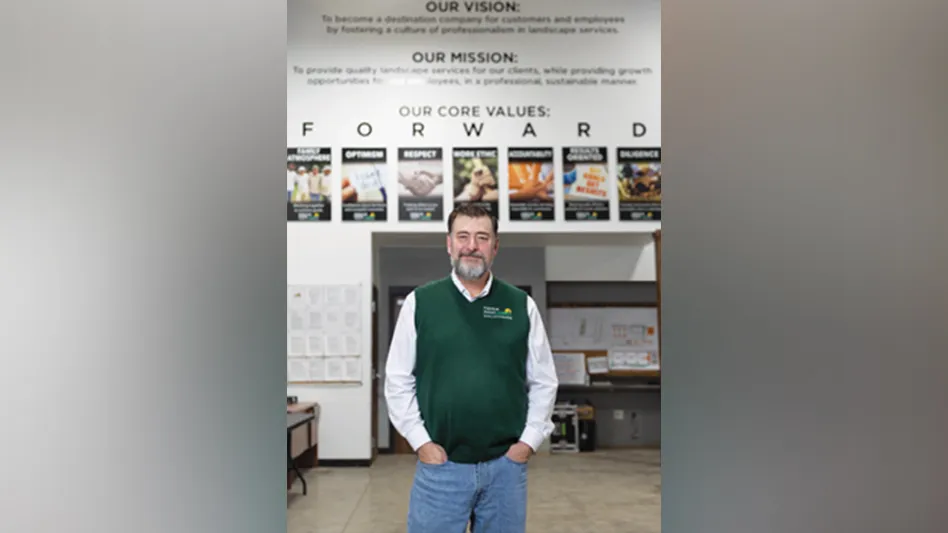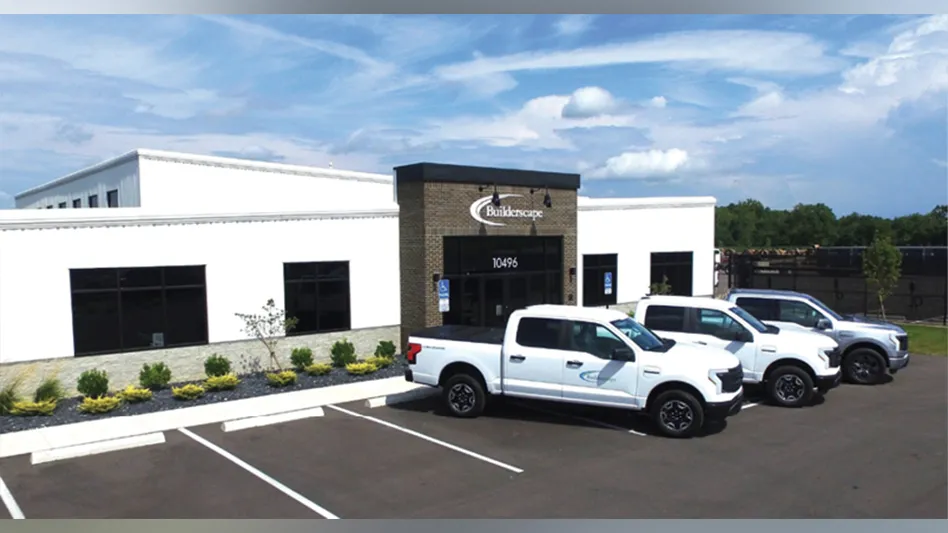The premise is simple. But the product? Increasingly sophisticated. For landscape contractors, efficiently beautifying and maintaining the great outdoors means a choice of zero options – zero-turn options, to be precise.
In an industry that exists “to make tall grass short” – this according to Ferris Product Specialist Roy Dust – landscape contractors are opting for progressive zero-turn technology to get the job done faster without sacrificing quality.
THEN VS. NOW. Dust, a 21-year veteran of Ferris Industries, Munnsville, N.Y., says older zero-turn machines bear little resemblance to those of today. “The first zero-turn mowers were chain-drive mowers,” he explains. “Although they were functional, the maintenance cost was high, they didn’t wear well and they weren’t reliable. But the improvements have been tremendous.”
Though the 1960s is the decade claiming the first zero-turn technology, the past few years have seen double-digit growth for numerous manufacturers due to a focus on new innovations. One example is independent suspension, which Dust says “can protect the machine from abuse and increase operator comfort, which can be helpful on large job sites.”
Additionally, designs incorporating a low center of gravity and even weight distribution prove to be key advancements for ease of use. According to Randy Harris, senior marketing manager for landscape contractor equipment, Toro, Bloomington, Minn., those two concepts have dramatically improved hillside stability in zero-turn riders. “This has broadened their utilization because, early on, they had a reputation of being more of a ‘flatlander’ machine.”
However, most manufacturers primarily agreed that recent years have juxtaposed true “innovation” with “improvements,” such as the onset of using diesel engines and alternative fuels.
Of diesel engines, Harris says, “they can deliver greater fuel efficiency and substantially greater torque, which translates into more power for mowing, mulching or bagging in demanding conditions. In addition, diesel engines have a longer life, lasting roughly three times as long as gasoline engines.”
“Alternative fuels are becoming very important,” Dust agrees. More than diesel alone, he says propane is more accepted today due to its production of lesser emissions. “We see Ozone Days in some parts of the country, and that’s only going to continue.”
Tim Cromley, Walker Manufacturing, cites the late 1980s move to an enclosed final drive as a distinct advancement. The marketing manager of the Fort Collins, Colo. company says that landscape contractors need not worry about chain adjustment with an enclosed final drive, as a connection exists from the drive to the transmission. “The machines don’t have the potential for wear. They’re cleaner running, working parts don’t need to be lubricated, and they have a more durable platform.”
In terms of the weight of recent zero-turn mower advancements, Cromley considers the advent of the liquid-cooled electronic fuel injection (EFI) to be of an innovative caliber. “Liquid-cooled EFI is basically the same engine that’s in your car. The result has been longer-lasting engines paired with considerable fuel efficiency.”
“Your engine is running at a good temperature,” Cromley says, “which solves the long-term issue of operating with a reliable engine, as well as the immediate issue of benefitting from fuel savings.”
Because the adage “Time is money” rings true, manufacturers insist quality is of the utmost importance in reducing machine downtime – especially when many landscape contractors have a limited number of zero-turn mowers in their fleets. Some manufacturers are pairing sturdiness and customization with a use of 7-gauge high-strength steel in deck construction, which provides an adjustable discharge baffle. Essentially, this allows the zero-turn operator to fine-tune the cutting and discharge performance of the deck upon encountering challenging and changing turf conditions. The decks can then potentially be “dialed in” to provide the most appropriate cut.
KNOW YOUR NEEDS. As is the case in any competitive industry, dealers of zero-turns may tend toward informing clients of their needs, encouraging models that may not be the most appropriate for a contractor’s operations. Beware of the nuances and features that may not provide practical solutions, manufacturers warn, reporting the following to be mainstays in considering which model to purchase.
“A lot of contractors are being told by dealers what their needs are,” explains Cromley. “Contractors have to define what their needs are; they’re the ones spending the money, so they need to avoid being convinced by price or by a salesperson who is misinformed on the scope of their operation. I’m a consumer too, and I’m as guilty as the next guy. Take cereal, for instance. I’ll buy the brand that’s 50 cents off or buy one, get one free. But this is premium equipment, so contractors have to think differently than when they’re standing in the cereal aisle. If you don’t go into a dealership knowing what your needs are, the dealership will be happy to determine your scope for you.”
Cromley suggests a demonstration on one of the contractor’s properties to answer questions. Some upfront questions for contractors to think about: What conditions are you mowing? Are you mowing a lot of hills? Do you catch grass? If so, do you need an integrated grass handling or leaf-cleanup system? What quality of cut do you want? Do you want a bigger zero-turn for larger fields? Or will you be maneuvering around gates and trees, necessitating a smaller deck?
Contractors agree that durability is among their top needs, regardless – or perhaps due to – their job-site conditions. Parts availability and servicing are of equal weight, they say.
For example, Ron Knesal, area manager/operations manager, Pacific Landscape Management, Hillsboro, Ore., says they have only five zero-turn mowers. When one is in the mechanic’s bay, they resort to back-up equipment, which makes the operation less efficient. “So far it’s been easy to get parts, which is critical. We have an advantage because we perform our own maintenance, but we can’t be waiting on components to be shipped to us. The availability of parts is crucial.”
“Durability is the price of admission in this business,” Harris continues, adding that most contractors keep this attribute top of mind when making a purchase. He explains that machines have to stand up to hours of being trailered around town, jumping curbs on jobs, absorbing impact from close trimming and mowing acres of turf each day.
Additionally, mowing decks must cut well, so as to prevent the need for double or triple cutting. The quality of cut is crucial when time savings is an issue, regardless of whether or not the machine is side-discharging, mulching or bagging, as well.
Noting that contractors should look for a dealer who puts them at the front of the line when they need parts and service, Harris suggests purchasers ask, “Are service parts readily available from the manufacturer? Does the dealer have a healthy supply of parts in stock? Ask about warranty coverage – some brands are more lenient than others. Talk with your dealer’s mechanic, and ask which manufacturers provide the best parts support, and who will work with them if they have a warranty issue.” Harris explains that a typical commercial warranty consists of two years on the engine, pump and motor, spindles, deck and frame, which are the components that are expensive to replace.
“If you’re spending $10,000 to $12,000, you don’t want to be buying a machine from 2,000 miles away,” Cromley shares. “You need readily available parts and well-trained technicians who keep up to date on the current production of your mower. It answers the question as to why dealerships fail – when they think it’s just about selling trimmer oil.”
“I would buy a poorer product from a better-servicing dealer, than the other way around,” Dust adds.
As a former landscape contractor himself, Dust deems quality performance a necessity. Contractors are finding a niche with cut quality, combined with overall productivity – not just speed, he explains. For a growing number of contractors, he says, “striping” is the buzzword. “When landscapers are trying to differentiate themselves from their competition, it’s what their job site looks like after they’re gone. Whether it’s commercial or residential, neighbors or neighboring businesses are saying, ‘My lawn doesn’t look that good,’ and they change contractors.” Of the patterned cuts, he says, “It’s not that hard to accomplish the look, so better landscape companies are using it to separate themselves. In industry conversations, striping is something that gets mentioned everyday. Two years ago no one talked about it, so it’s definitely become a trend in terms of what contractors want.”
Indeed, Knesal likens striping to an effective calling card. “We’ve recently put striping kits on our mowers,” he says. “It’s appealing, and it shows people there’s quality in our work, thereby aiding in referral business. And we don’t do any advertising besides the work we do.”
Certainly not a category to be overlooked is safety. The acronym of choice is “ROPS” or a Roll Over Protection System. Though not universally standard, the roll-bar system protects the operator and the mower in case of an accidental turnover. Certified to OSHA standards, ROPS have proven successful in preventing injury and death in small agricultural tractors. Zero-turn mower manufacturers expect the system will be standard in the near future.
To purchasers, Harris suggests not only buying a machine equipped with ROPS, but also one that is ANSIB71.4 compliant. “This is a voluntary standard for commercial mowers that was enacted for safety,” he says. “It means the machine conforms to standards like maximum blade-tip speed, maximum blade-stopping time, thrown-objects limits, minimum stability on hillsides … it protects the operators who are racing the clock everyday, and it protects the business.”
As an alternative to buying a new zero-turn in light of safety concerns, many mower manufacturers will retrofit older models of zero-turn mowers with ROPS.
To a lesser degree, ergonomic additions to zero-turns are a trend; however, it’s not necessarily viewed as practical to contractors. Dust explains, “Yes, ergonomic features are important but, honestly, they are nice for first impressions,” he says. “If you’re looking at buying a new car, and you can’t find the gear shift, and the seat is uncomfortable, you’re less likely to buy that car. If you’re the owner and operator, you’ll consider that. But to be honest, especially when you’re dealing with large landscape maintenance operations, the purchaser isn’t the one sitting on the machine. They don’t care. They should, but they don’t. Most of the time when I’m talking ergonomics, the purchaser is saying, ‘Tell me something I want to know.’”
Dust says that ergonomic designs actually address safety concerns, so it should be considered in a purchase. For instance, an operator needs to be able to quickly control blade engagements. If it’s in a hard-to-reach place, and the operator needs to act quickly, the choice to ignore ergonomics may prove a dangerous one. According to Dust, if the purchaser is also the person responsible for writing compensation checks, opting for ergonomics suddenly has more influence.
In general, Harris agrees. “I can’t necessarily say contractors want more ergonomically friendly machines. They want improved comfort and simplified controls. They want to know where everything is.” For that reason, some manufacturers have clustered their levers – choke, throttle, ignition, PTO – in one area.
But for day-to-day practical use, Dust says, contractors should stick to the basics. “Contractors need to look for quality and durability,” he points out. “They should look for a lack of gimmicks, because gimmicks normally complicate a piece of equipment. Do you need a fancy instrument to tell you when to change the oil? If you don’t have a good maintenance program, the little electronic gimmick won’t help. More people are talking about laser guidance and futuristic gadgets – I just think it’s way too much. Sometimes the KISS or ‘Keep It Simple, Stupid’ principle works best for our industry.”

Explore the February 2006 Issue
Check out more from this issue and find you next story to read.





